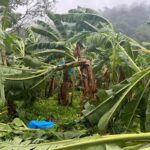Opinion: fruit market dependency on Southern Hemisphere's variable weather
By Digit Scans co-founder and BerryBroad Juanita Gaglio
 As international trade in fruits and vegetables expands, consumers are benefiting from a wider variety of produce to choose from and year-round-supply due to increased trade between the Northern and Southern Hemispheres. Among all the agricultural sectors, fruit and vegetable trade has expanded at a higher rate than other agricultural commodities, according to USDA statistics from 1980 to 2004.
As international trade in fruits and vegetables expands, consumers are benefiting from a wider variety of produce to choose from and year-round-supply due to increased trade between the Northern and Southern Hemispheres. Among all the agricultural sectors, fruit and vegetable trade has expanded at a higher rate than other agricultural commodities, according to USDA statistics from 1980 to 2004.
Crops grown in the Southern Hemisphere are exposed to a milder climate than in the Northern Hemisphere due to the pattern of air currents, less pollution, and the angle of the sun in terms of the length of day required for harvest. Geographic patterns play a key role in a variety of micro-climates ranging from semi-arid to Mediterranean in these countries. For example, Chile has five different growing regions which leads to a wide range of agricultural exports from grapes to poultry, fish and timber.
While Chile leads these countries as the region’s leading exporter with around 35% of total fresh fruit exports, South Africa accounts for nearly one fifth of the market share with a focus on Europe. New Zealand and Argentina together account for almost another third.
The USDA states the leading fruit imports are bananas, followed by juices with orange juice – mainly from Brazil – representing 70% of trade and apple juice coming in second at 11%. Between 1999 and 2001, around 60% of the North American Free Trade Agreement (NAFTA) area’s fresh fruit imports came from the Southern Hemisphere, while 45% of fruit juice imports came from the region.
Further ‘down under’, major Southern Hemisphere export players New Zealand and Australia export proprietary branded apples Jazz and Pink Lady, as well as kiwifruit and citrus chiefly to the European Union and North American markets. According to the New Zealand Ministry of Agriculture and Forestry, annual export earnings for the apple industry range from NZ$350 million (US$295.8 million) to NZ$400 million (US$338 million). Meanwhile the Australian state of Victoria is a significant player in the U.S. navel orange market.
Given the lucrative value of Northern Hemisphere markets, Southern Hemisphere countries have come to depend on export market growth. Likewise, Northern Hemisphere consumers have become accustomed to serving cherries at Christmas time and consuming fresh apples and oranges in the summer months. Retailers and produce companies related to agriculture also benefit by designing global strategies for sourcing products that optimize their cost structures and keep them competitive.
So all the constant variables are there to bring these commodities to market, exchange rates play an important part too, but there is one significant uncontrollable factor - extreme weather conditions.
How weather conditions influence the supply side
Among the diverse factors affecting production such as supply of suitable land and infrastructure, the most critical and variable factor is the weather. Some crops can be stored while others have a limited shelf life for consumption and processing shortly after harvest. Crops, such as grapes and apples can be held and shipped to market in a climate-controlled atmosphere; weather permitting.
During the past few years, natural disasters and extreme weather conditions have not been kind to crop production in Southern Hemisphere countries. More than two-thirds of the world’s large-magnitude earthquakes occur on South America’s west coast. In February 2010 an 8.8 magnitude earthquake struck Chile, which cut off major supply routes, leading to some fruit falling off trees and ultimately delays in grape shipments to export markets.
In August 2007, a strong 8.0 earthquake struck the Peruvian cities of Pisco, Ica and Chincha Alta in the agricultural Ica region. This region is an important grape-growing region with Pisco as a port city. Two years prior in September 2005, a 7.0 earthquake struck but this did not impact agricultural regions.
Given the vagaries of climate change, over the last few months there has been significant crop damage due to shifts in rainfall patterns, floods, coldsnaps and record snowfalls. This year an unexpected coldsnap and record snowfall of 31.5 inches affected varieties of peppers and tomatoes in Chile’s Atacama Desert, which is known as the driest place on earth, stretching 600 miles from Peru’s southern border into northern Chile.
July’s cold temperatures in Santiago, Chile made it the coldest July since 1908, according to the Universidad de Chile. The frost adversely affected avocado and citrus crops. In December 2010, rain and hail damaged up to 10% of the blueberry crop in the northern growing regions of Chile.
Conversely, another Southern Hemisphere country, South Africa, experienced a year-long drought in 2010 affecting the citrus growing regions of the Eastern Cape. Insufficient water affected yields and fruit sizes. This region heavily depends on citrus exports for their income.
A State of the Environment report issued by the Australian Government states that Australian farmers have suffered from major drought problems in the last decade, along with bushfire loss. According to Australian crop insurance records, the highest amount of insurance claims due to hail-storm damage came from New South Wales, with the northern tablelands to be one of the hail-prone regions of the state.
Severe winds can also have major financial impact on crop loss. In February 2008, a wild storm in south-east Queensland with a speed in excess of 150 mph snapped trees, flattened fences and shredded lettuce crops.
As we have become accustomed to out-of-season fruits and vegetables in our supermarkets, extreme weather impacts the entire supply chain from decreased export volumes to higher consumer prices. An aberrational volcano in Iceland can reverberate all the way to the Southern Hemisphere countries. Climate change will have a significant impact on crop yields. An increase in temperature will shorten crop cycles with decreasing crop yields. An increase in precipitation could lead to an increase in erosion.
The challenge will be for Southern Hemisphere growers to develop more resilient crops and improved forecasting models. Weather permitting, fruits and vegetables can continue to play a major role for these export economies.
Related story: Changing climate, changing Southern Hemisphere fruit industry











































